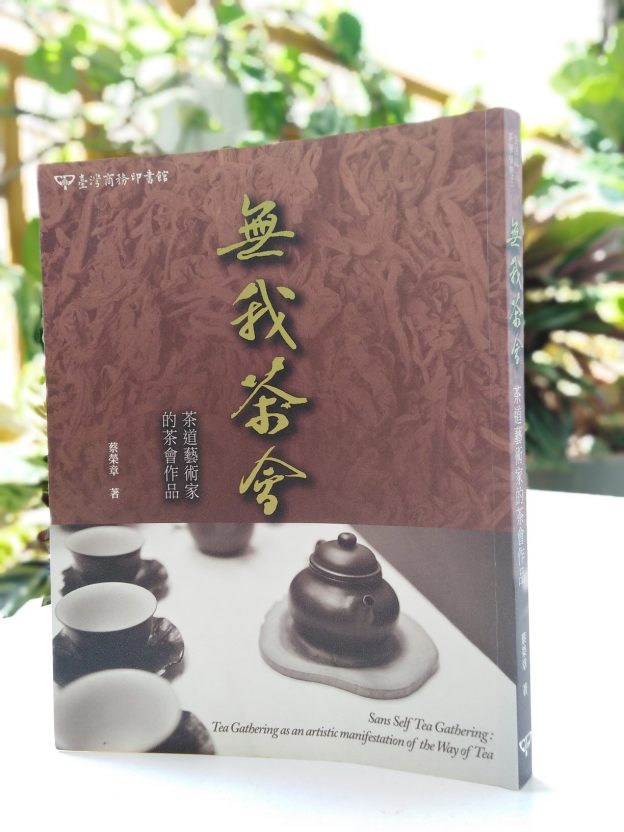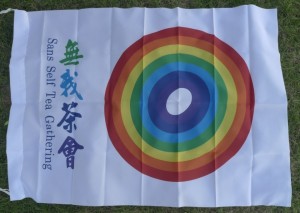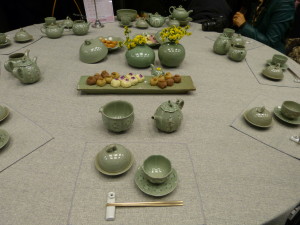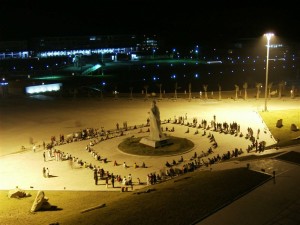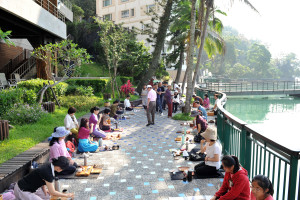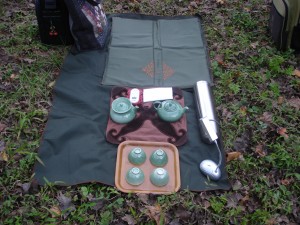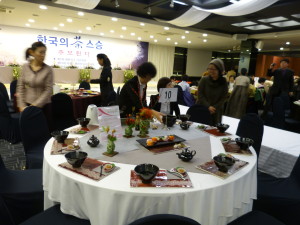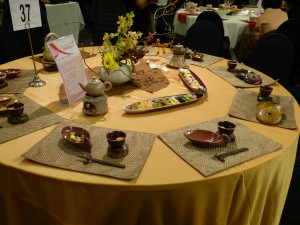《無我茶會Sans Self Tea Gathering (Wu-Wo Tea Ceremony)180條》
蔡荣章著Author:Rong-tsang Tsai
ISBN 978-957-9690-08-9,“无我茶会Sans Self Tea Gathering(Wu-Wo Tea Ceremony) 180” ,First edition: 1999.9, Second edition: 2010.9.《无我茶会180条》,1999.9第一版,2010.9第二版.台北陆羽茶艺股份有限公司.2012.05.20修订版.-English Translator : Katherine Yip,英语翻译:叶德明.
Chapter 13 A Brief History of Sans Self Tea Gathering
172. The Origin of Sans Self Tea Gathering
The prevailing ethos pertaining to tea in Taiwan in the 1990s gave birth to a unique form of tea gathering. The concept was initiated by Rong-tsang Tsai, then general manager of Taipei’s Lu Yu Tea Art Centre in 1989. The inaugural Sans Self Tea Gathering was held in 1990.
173. What led to the birth of Sans Self Tea Gathering?
There were both internal and external factors. The one mentioned above was an internal factor. Meanwhile, there were two external factors. Firstly, as was the tradition, a person would brew and serve tea to a few guests; or, a few brewers serving a larger number of guests. The problem was, this hardly reflected the spirit of the Way of Tea. There was the need to introduce a new format whereby everyone brews, serves and enjoys tea. Secondly, it was hard to effectively promote the Way of Tea because the number of participants was small. An aspiration to host a new kind of tea gathering for a larger group of people to share the Way of Tea became the catalyst behind Sans Self Tea Gathering.
174. The first-ever Sans Self Tea Gathering.
On May 26, 1990, Rong-tsang Tsai presented the draft of the ‘Sans Self Tea Gathering’ framework during the first ‘Teacher Training Course of the Way of Tea’ by Lu Yu Tea Art Centre; feedback and comments were collected from those present. At the end of the discussion, it was decided that a pilot Sans Self Tea Gathering for 12 participants would be held at the妙慧佛堂 near Lu Yu Tea Art Centre. This was the first -ever Sans Self Tea Gathering. A review was held immediately afterwards, and the decision for a second Sans Self Tea Gathering was made. The format of Sans Self Tea Gathering was subsequently confirmed after three experimental tea gatherings.
175. The first Sans Self Tea Gathering in public
It has been the practice to have a tea gathering after the certificate presentation ceremony of ‘Assessment Examination for Lu Yu Tea Brewers’. On June 20, 1990, a Sans Self Tea Gathering was held at the Guangfu Auditorium of the Zhongshan Hall in Taipei in tandem with the 13th Certificate Presentation Ceremony. There were 70 participants, comprising both veteran and new tea brewers. The Tea Brewer Certificates were presented to the graduates by the veterans after the tea gathering. This was the first Sans Self Tea Gathering held in public.
176. The first International Sans Self Tea Gathering
Sans Self Tea Gathering was first introduced to members of the Japanese and Korean tea fraternities during one of the gatherings for the exchange of tea culture. They were bowled over by this unique form of tea gathering, and brought back writings and videos for sharing with fellow tea drinkers. On December 18, 1990, the first International Sans Self Tea Gathering took place at the Meditation Centre of 「十方禪寺」in Taipei. More than 70 fellow tea drinkers from China, Japan and Korea attended the tea gathering. In the earlier days, Sans Self Tea Gathering were mostly held at Buddhists temples or meditation centres because of the spacious environment.
177. Publications of Sans Self Tea Gathering
To promote Sans Self Tea Gathering, ‘Wu-Wo Tea Ceremony’ was launched in March 1991. Available in Chinese, Japanese, Korean and English, it is a concise guide to the format and spirit of Sans Self Tea Gathering.
At the beginning of 1997, a set of teaching materials about Sans Self Tea Gathering was compiled to facilitate class discussion. This was essentially a set of 180 related issues observed over the years. In early 1999, the ‘Chinese International Sans Self Tea Gathering Promotion Association’, in response to the need of the ‘Classes on the Way of Tea’, undertook to produce six textbooks for tea studies. ‘Wu-Wo Tea Ceremony, 180 Steps’ was selected as one of the six textbooks. It was published in September the same year, ahead of the others. This was a more comprehensive record of the ideologies and served as an ‘operational manual’ of Sans Self Tea Gathering.
In the winter of 2012, we updated ‘Wu-Wo Tea Ceremony 180’ and incorporated some conceptual interpretation. It was translated into English and renamed 《Sans Self Tea Gathering: Tea Gathering as an artistic manifestation of the Way of Tea》.
178. The First Sans Self Tea Gathering Stone Tablet at the Wuyi Mountain
At the second International Sans Self Tea Gathering held on October 17, 1991, a memorial stone tablet was erected in the courtyard of the Wuyi Mountain Villa located at the foothill of the Manting Peakt, a day before the morning event, thanks to the effort of everyone concerned, and in particular the assistance of deputy managing director Liu Caihua and director Lin Xing of the Wuyi Mountain Villa. On the front of the stone tablet was carved the subject of the event: ‘Sans Self Tea Gathering at Manting Peak’ and an inscription translated as follows: ‘On October 17, 1991, more than a hundred tea aficionados gathered together at the Manting Peak. Each person brought along his/her own tealeaves and tea ware. Seated in a circle, each participant brewed four cups of tea, and offered three of these to fellow drinkers on the left while reserving one for own consumption. This way, everyone brewed and served tea on equal standing’. On the back of the stone tablet was carved: ‘The Spirit of Sans Self Tea Gathering’ and an inscription translated as follows: ‘Seats are decided by random drawing, not seniority and status. Tea is served to the left and received from the right, without expectation of reciprocation. Tea, regardless of its quality, is received readily. Brew the best tea possible and aspire to keep improving. The event proceeds as agreed without the need of direction for the cultivation of understanding and cooperation as a team’.
Our gratitude also goes to renowned calligrapher Huang Meifeng for the calligraphy of the tablet inscription and famous stone carver He Shuangshui for carving it out.
179. From ‘Sans Self Tea Gathering Promotion Committee’ to ‘Chinese International Sans Self Tea Gathering Promotion Association’
During the fledgling period of its development, Sans Self Tea Gatherings were held at the Lu Yu Tea Art Centre; seminars and related activities were organized in the name of Sans Self Tea Gathering Promotion Committee. In August, 1994, the ‘Chinese International Sans Self Tea Gathering Promotion Association’ was established with the approval of the Taiwanese Government. It is an independent incorporated association with its registered address at the Lu Yu Tea Art Centre, where the office of the Association was located, thanks to the Lu Yu Tea Art Centre.
180. Milestones of Sans Self Tea Gathering (1989~2012)
1990.05.26 Discussion of the draft proposal of Sans Self Tea Gathering
1990.06.02 The 1st pilot Sans Self Tea Gathering
1990.06.23 The 1st Sans Self Tea Gathering in public was held in tandem with the 13th Certificate Presentation Ceremony for Tea Brewers
1990.11.14 This unique idea was introduced to overseas tea drinkers during the ‘Purity’ Sans Self Tea Gathering held at a Buddhist Temple where 20 Chinese and Japanese tea drinkers gathered together
1990.12.18 The 1st international Sans Self Tea Gathering was held in Taiwan. Participants included Chinese, Japanese and Korean tea drinkers.
1991.03.01 ‘Wu-Wo Tea Ceremony’, a book dedicated to Sans Self Tea Gathering, was published in Chinese, Japanese, Korean and English.
1991.03.27 Sans Self Tea Gathering was incorporated into the curriculum of Lu Yu’s the Way of Tea classes from its 50th Tea Brewing Seminar onwards.
1991.05.12 70 people participated in the ‘Mother’s Day Familial Bonding’ Sans Self Tea Gathering held at the National Chiang Kai Shek Cultural Centre, Taipei.
1991.08.04 100 fellow tea drinkers gathered by the Lily Pond at the Taipei Botanical Garden for the ‘Lily Appreciation’ Sans Self Tea Gathering.
1991.09.08 50 tea drinkers organized a ‘Back to the Basics’ Sans Self Tea Gathering at the浩然敬老院.
1991.10.17 About 100 Chinese, Japanese and Korean tea drinkers participated in the 2nd International Sans Self Tea Gathering held at the Wuyi Mountain. A stone tablet was erected to commemorate the occasion.
1991.10.20 Members from the Taiwan delegation who had attended the 2nd International Sans Self Tea Gathering hosted a Sans Self Tea Gathering briefing at the Hong Kong Museum of Tea Ware.
1992.05.05 A briefing on Sans Self Tea Gathering was held during the 3rd Festival of Ceramics Art at Yixing.
1992.05.07 A briefing on Sans Self Tea Gathering was held at the Huxin Ting, Shanghai
1992.09.20 60 people from Taipei and Kaohsiung participated in the ‘Monastery’ Sans Self Tea Gathering held at the Main Shrine of Fo Guang Shan Monastery, Kaohsiung
1992.11.09 The 3rd International Sans Self Tea Gathering took place in Japan, with one session each at Kinkaku-ji , Choan-ji and Amanohashidate. These gatherings were attended by 200 Chinese, Japanese and Korean tea drinkers.
1993.02.06 Rong-tsang Tsai suggested using rainbow as the source of inspiration for the design of the flag of Sans Self Tea Gathering during the ‘YuanXiao Lantern’ Sans Self Tea Gathering at the house of fellow tea drinker Liao Chunyu.
1993.10.13 The 4th International Sans Self Tea Gathering was held at the Imperial Palace (Gyeongbokgung) of Korea, with 350 Chinese, Japanese and Korean tea drinkers attending the event.
1994.05.01 The Lu Yu Tea Art Centre set up the ‘Sans Self Centre’ dedicated to the training of Sans Self Tea Gathering.
1994.05.08 500 people attended the ‘Jiaxu Mother’s Day Familial Bonding’ Sans Self Tea Gathering at the Square of the National Chiang Kai-shek Memorial Hall.
1994.08.10 120 international students attending the annual general meeting of the International Association of Students in Economics and Business Management participated in a Sans Self Tea Gathering Demonstration and Practice session held at Lai Lai Sheraton (now Sheraton Grande Taipei Hotel), Taipei.
1995.05.31 The Way of Tea Society of the Christ’s College in Guandu, Taipei, hosted the inaugural Tea Studies Seminar. A Sans Self Tea Gathering was held in the evening in tandem with the certificate presentation ceremony.
1995.10.27 The 5th International Sans Self Tea Gathering had two tea gatherings held at Wuyi Mountain’s scenic spots of Yun Wo and Peak Yunu respectively, each with about 200 participants.
1996.05.05 The year’s ‘Mother’s Day Familial Bonding’ Sans Self Tea Gathering was simultaneously held in 10 cities and towns in Taiwan, attended by more than 1,200 people.
1996.09.25 An evening Sans Self Tea Gathering attended by the Prison Warden and 50 inmates was held at the Taiwan Wuling Open Prison, Taitung. The gathering was themed ‘Celebrating the Moonlight of Wuling with Fragrant Tea’.
1997.01.12 A talk and demonstration on ‘The Organization and Spirit of Sans Self Tea Gathering’ was held at the Lecture Hall, Hong Kong Museum of Art during the Hong Kong Tea Art Competition. A 50-people Sans Self Tea Gathering was held after the session at the Tsim Sha Tsui Waterfront.
1997.01.14 30 Malaysians participated in a Sans Self Tea Gathering Workshop at the Chan She Shu Yuen (Chan Clan Temple Library) located in Jalan Petaling
1997.02 A set of teaching materials about Sans Self Tea Gathering was compiled as ‘Wu-Wo Tea Ceremony, 180 Steps’ for class discussion.
1997.03.08 Taiwan’s United Daily News published a 2/3 page story on Sans Self Tea Gathering and Tea ware on-the-go. The title was: ‘Renaissance of Chinese Tea – a world with no seniority, reciprocation and preference – Sans Self Tea Gathering expresses the Beauty in Quietude’.
1997.11.22 The 6th International Sans Self Tea Gathering was held at the National Chiang Kai Shek Cultural Centre, Taipei with a thousand people attending; following which a Sans Self Tea Gathering was held at the Koahsiung Chiang Kai Shek Cultural Centre on 26th November with 500 participants.
1998.03.07 The tea fraternity in Singapore hosted a multi-racial Sans Self Tea Gathering with 100 participants.
1998.05.04 The University of Peking’s Society of Oriental Tea Culture Research organized a Sans Self Tea Gathering to celebrate the university’s centennial.
1999.10.16 The 7th International Sans Self Tea Gathering, co-organized by the Zhejiang Tea Society and the Zhejiang Association of Science and technology, was held at Hangzhou, Xincheong and Tiantai respectively.
2001.05.06 A ‘Global Mother’s Day Familial Bonding’ Sans Self Tea Gathering took place in 11 cities around the world; these include 8 areas in Taiwan, and Hanzhou, Italy and Singapore, among others. More than 1,000 tea drinkers celebrated Mother’s Day by participating in the dedicated Sans Self Tea Gathering.
2001.10.07 The 8th International Sans Self Tea Gathering took place in Japan with one session each in Aichi (October 7), Shizuoka (October 8) and Inasa (October 9) ; there was a total of 250 participants
2003.04 A Lu Yu Tea Art Centre was opened in Beijing. The teaching of Sans Self Tea Gathering has since been incorporated into its Tea Art Seminars.
2003.10.16 A ’Commemorative Lu Yu Sans Self Tea Gathering’ was organized at Tianmen of Hubei Province in tandem with the seminar on Cross-Strait Lu Yu Tea Culture and Development of the Tea Industry; in addition, a ‘Cross-Strait Tea Drinkers’ Golden Autumn Sans Self Tea Gathering’ was held at the Anhui Agricultural University on October 20.
20040.05 The annual ‘Mother’s Day Familial Bonding’ Sans Self Tea Gathering evolved to the ‘World Tea Offering Day’. Tea drinkers the world over are invited to offer tea to family, friends and strangers during the first weekend of May through the participation in Sans Self Tea Gathering.
2004.08.21 The 9th International Sans Self Tea Gathering was held at the Marina City Park in Singapore with 500 participants.
2005.11.02 The 10th International Sans Self Tea Gathering took place at the Wuyi Mountain of Fujian Province, with one session each at the Wuyishan National Tourism Resort (November 2) and Wuyishan Town Stadium (November 3); there was a total of 300 participants.
2007.09.28 Tenfu Tea College (now Zhangzhou College of Science and Technology) was set up in Pantuo of Zhangzhou, Fujian Provice. The one-semester Sans Self Tea Gathering course was incorporated into the curriculum of its Tea Culture studies.
2007.10.13 The 11th International Sans Self Tea Gathering was organized in Korea, with one session each at the Wonkwang University, Iksan (October 13) and Changgyeongung Palace, Seoul (October 14); there was a total of 400 participants.
2009.10.18 The 12th International Sans Self Tea Gathering took place in San Francisco with the attendance of more than 100 tea drinkers from China, Taiwan, Japan, Korea and the United States.
2011.05.28 The 13th Sans Self Tea Gathering took place in Taiwan; a thousand-participant Sans Self Tea Gathering was organized at the National Chiang Kai Shek Cultural Centre, Taipei on the May 29. This was followed by the ‘Daybreak’ Sans Self Tea Gathering by the side of the Sun Moon Lake on the May 30 with 400 participants, and the ‘Dawn’ Sans Self Tea Gathering at the Amitabha Buddhist Temple, Alishan on May 31 with 300 participants.
2011.06.17 Documentation of information and reading materials related to Sans Self Tea Gathering began. Website: http://www.contemporaryteathinker.com
2012.05.27 美國拉斯維加斯茶文化學會在當地舉辦一場「沙漠甘泉無我茶會」。
2012.09.09 汶莱中华文艺联合会邀當地居民30人舉行無我茶會,馬來西亞紫藤文化企業集團茶藝學習中心主任許玉蓮前往指导。
(2802)
